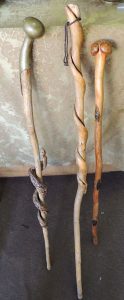Personal Effects: Walking sticks
Published 8:30 am Monday, October 9, 2017
Question: Jerry, I have a small collection of walking sticks that were either my father’s or that I bought years ago. I recently attended an auction where walking sticks sold for high prices and that got me wondering about mine.
My father found the one with a snake coiled around it in Eastern Kentucky. The snake is separate from the stick but doesn’t come off, and the stick has a brass knob on top. The one with little fanciful animal heads painted on it I bought from a folk artist in upstate South Carolina about 25 years ago. I remember paying him $12 for it.
I also have a few more sticks which had honeysuckle or other vines growing around the saplings to make them twisted. I keep them in the umbrella stand. Are they worth collecting?
 Answer: Of course they are worth collecting! I’m pretty sure that I know the recent auction you speak of. Prices were high and rightly so. Good things still bring good money. Many times one thinks of canes as being used by the infirm or elderly. But in the 19th century they were a fashion accessory. Canes or walking sticks were carried by rich and poor, able bodied and fragile alike. No self-respecting man would be out with out a cane or walking stick of some kind.
Answer: Of course they are worth collecting! I’m pretty sure that I know the recent auction you speak of. Prices were high and rightly so. Good things still bring good money. Many times one thinks of canes as being used by the infirm or elderly. But in the 19th century they were a fashion accessory. Canes or walking sticks were carried by rich and poor, able bodied and fragile alike. No self-respecting man would be out with out a cane or walking stick of some kind.
Carved or folk art canes have been around for generations, centuries in fact. They are a type of vernacular folk art. In this case, vernacular just means an object used or created by ordinary people from a particular region or area. Not just canes, but all forms of folk art were used to allow a person, male or female, in more rural areas to express them selves in the form of the arts. Poorer people who didn’t have time or the money for art classes could still express themselves in the objects they made and used.
You began to see a greater appreciation in the 1960s and ’70s as terms like “folk art” and “outsider art” became more and more commonly used. These ordinary people were seen as the amazing artists that they were and are. Today it’s a hot commodity and and there are numerous books on the subjects. In fact, I think that canes are one of the next things to take off in the folk art arena.
Weather vanes, cigar store Indians and ship figure heads are all long gone in regards to finding a masterpiece in someone’s barn or shed. Canes are still out there in cane stands just waiting.
I love your canes and think they are worthy of many collections. I think that the most important cane that you’ve shown me is the one on the left with the brass horse hame and that great carved rattlesnake. That cane should in a retail environment sell for about $175. The others could retail for about $50-$75 each. Now with some luck, time and research these prices could go up. Thanks for sharing them.





